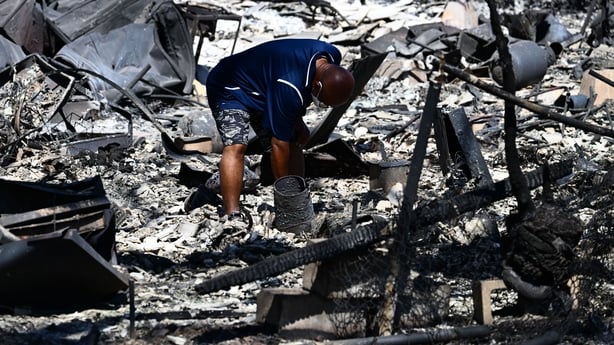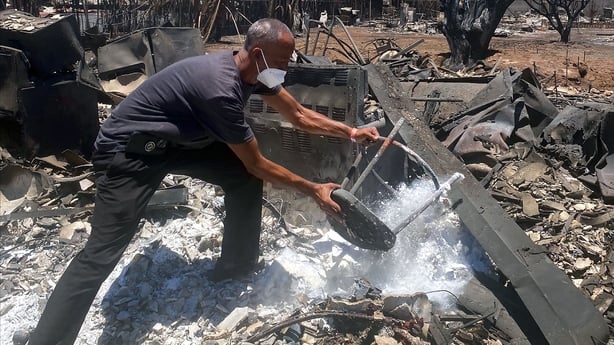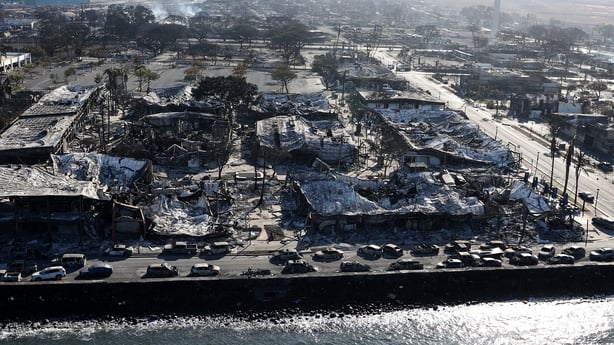Hawaii's attorney general has said she was opening an investigation into how authorities responded to devastating wildfires that have left at least 80 people dead.
Maui county officials also said that 1,418 people were at emergency evacuation shelters.
"The Department of the Attorney General will be conducting a comprehensive review of critical decision-making and standing policies leading up to, during, and after the wildfires on Maui and Hawaii islands this week," a statement issued by the office of Attorney General Anne Lopez said.
The announcement came as criticism grows over the official response to the blazes, the most serious of which tore through the historic town of Lahaina, reducing it to ashes.

Residents have complained that there were no warnings about the fire, which trapped people in the town.
"The Department of the Attorney General shares the grief felt by all in Hawaii, and our hearts go out to everyone affected by this tragedy," the statement said.
"My department is committed to understanding the decisions that were made before and during the wildfires and to sharing with the public the results of this review.
"As we continue to support all aspects of the ongoing relief effort, now is the time to begin this process of understanding," the statement said.
The fires became the deadliest natural disaster in the state's history, surpassing that of a tsunami that killed 61 people on the Big Island of Hawaii in 1960, a year after Hawaii joined the United States.
Read more:
'Everything is just red': Survivors tell of Hawaii wildfire 'warzone'
How did the Hawaii wildfires start?
Mick Fleetwood's restaurant burned down in wildfires
Officials have warned that search teams with cadaver dogs could still find more dead from the fire that torched 1,000 buildings and left thousands homeless, likely requiring many years and billions of dollars to rebuild.
Three days after the disaster, it remained unclear whether some residents had received any warning before the fire engulfed their homes.
The island includes emergency sirens intended to warn of natural disasters and other threats, but they did not appear to have sounded during the fire.
"I authorised a comprehensive review this morning to make sure that we know exactly what happened and when," Hawaii Governor Josh Green told CNN, referring to the warning sirens.
Officials have not offered a detailed picture of precisely what notifications were sent out, and whether they were done via text message, email or phone calls.

Mr Green described multiple, simultaneous challenges, with telecommunications down and firefighters concentrating on other major wildfires when the greatest threat to Lahaina arose.
In any event, he said, "we will do all that we can to find out how to protect our people more going forward".
Maui County Fire Chief Bradford Ventura said at a press conference on Thursday that the fire's speed made it "nearly impossible" for frontline responders to communicate with the emergency management officials who would typically provide real-time evacuation orders.
"They were basically self-evacuating with fairly little notice," he said, referring to residents of the neighborhood where the fire initially struck.
County Mayor Richard Bissen told NBC's Today show that he did not know whether sirens went off but said the fire moved extraordinarily quickly.
"I think this was an impossible situation," he said.
The disaster began unfolding just after midnight on Tuesday when a brush fire was reported in the town of Kula, roughly 56km from Lahaina. About five hours later that morning, power was knocked out in Lahaina, according to residents.

In updates posted on Facebook, Maui County said the Kula fire had consumed hundreds of acres of pastureland, but that a small three-acre brush fire that cropped up in Lahaina had been contained.
By that afternoon, however, the situation had turned more dire. At around 3.30pm, according to the county's updates, the Lahaina fire suddenly flared up. Some residents began evacuating while people, including hotel guests, on the town's west side were instructed to shelter in place.
In the ensuing hours, the county posted a series of evacuation orders on Facebook as the fire spread through the town.
Some witnesses said they had little advance notice, describing their terror when the blaze consumed Lahaina in what seemed a matter of minutes. Several people were forced to leap into the Pacific Ocean to save themselves.
The Lahaina evacuation was complicated by its coastal location next to hills, meaning there were only two ways out, at best, said Andrew Rumbach, a specialist in climate and communities at the Urban Institute in Washington.
"This is the nightmare scenario," said Mr Rumbach, a former urban planning professor at the University of Hawaii. "A fast-moving fire in a densely populated place with difficult communications, and not a lot of good options in terms of evacuations."
County officials began allowing Lahaina residents back to their homes yesterday, even though much of Maui's western side remained without power and water. But the long traffic jam on the Kuihelani Highway crawled to a halt after a collision killed a pedestrian and led officials to close the highway in both directions.
Volunteers formed human chains yesterday afternoon at Maalaea Harbor to transfer infant formula, nappies, clothes, fuel and other supplies onto boats.
Boat captains planned to sail around to the fire-affected areas and bring the supplies to the beach on jet skis, seconded from the area's tourism industry, as the waters were choppy and docks had been damaged by the fires.
The Maui blazes are the latest wildfires that have struck this summer around the globe. Fires forced tens of thousands of people in Greece, Spain, Portugal and other parts of Europe to evacuate, while in western Canada smoke from a series of severe fires blanketed a vast swath of the US Midwest and East Coast.
In a typical year, wildfires char less than 1% of Hawaii's acreage, about the same as other US states. But the spread of non-native, fire-prone grasses on former farmland around towns and a warming climate have elevated the threat of wildfires on the islands, according to the Hawaii Wildfire Management Organization.

